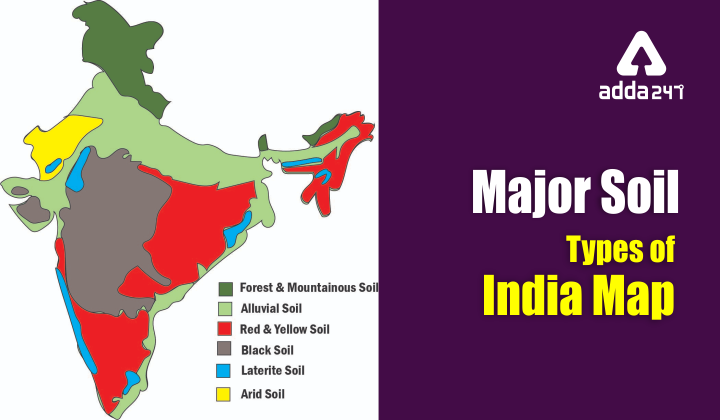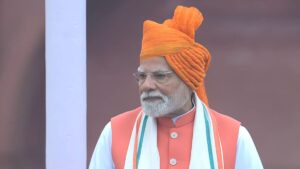Classification of Soil in India
Soil is a mixture of organic matter mineral liquids gases and microorganisms which together supports life. It consists of solid faces of mineral and organic matter, it also holds gases and water. Soil serves as a medium for plant growth, water storage, supply, and purification, modifying Earth’s atmosphere and habitat of several organisms. Soil is a major component of Earth’s ecosystem. The composition of the soil is 50% solid which includes 45% mineral and 5% organic and the other 50% is pores which are half occupied by water and half by gas. The major type of soil found in India is alluvial soil, red soil, black soil, mountain soil, desert soil, saline and alkaline soil, laterite soil, and peaty soil.
The soil was classified based on fertility either the soil was fertile or non-fertile. In the modern days, there are various characteristics to classify soil types based on texture, moisture, content, color, water holding capacity, etc. India is considered one of the most fertile countries based on soil. It was a belief that you can grow anything on the soil of India Map. In this article, we have included the different types of soil found in India.
Political Map of India
Types of Soil Found in India
- Major soil types of India map: Alluvial soil– alluvial soil is formed by the deposition of sediments brought by the river. As most of the rivers originate from the Himalayas, they bring along a high amount of sediments with them which deposit on the banks of the river. The alluvial soil is made of particles like clay, sand, and slit. Alluvial soil is highly fertile because it has an adequate amount of potash, lime, and phosphoric acid. Alluvial soil has two types old alluvium called Bangar and new alluvium which is called khadar. Alluvial soil is found in the delta of different rivers such as Mahanadi, Kaveri, Godavari, and Krishna in peninsular India. Alluvial soil is light green color and crops cultivated in alluvial soil are wheat, maize, sugarcane, rice, pulses, and oilseeds. Alluvial soil is found in the Northern plains beginning from Punjab to West Bengal and Assam.
- Major soil types of India map: Black soil– Black soil is made of Lava and volcanic rocks and is also known as “regur” which is derived from the Telugu word “reguda”. The major crop grown in black soil is cotton. This soil is rich in potash line magnesium carbonate and calcium carbonate which is adequate for growing cotton crops. Black soil is mostly found in Gujarat, Maharashtra, and Madhya Pradesh, it is also found in the southern part of India in the state of Andhra Pradesh, Karnataka, and Tamil Nadu. Black soil holds a lot of moisture and has a higher water holding capacity. Crops like cotton, wheat, millet, and tobacco can be grown in black soil.
- Major soil types of India map: Peaty soil– Peaty soil is formed by the accumulation of a high number of organic matter in the soil due to humid climatic conditions. The soil is low in potash and phosphate content. peaty soils are found in a few districts of Kerala, whereas marshy soil is found in the coastal areas of Tamil Nadu, Bihar, Uttaranchal, and Sundarbans of West Bengal. Peaty soil is black and has a high acidic content. This type of soil constitutes a used number of soluble salts and constitutes about 10- 40% of organic matter.
- Major soil types of India map: Saline and alkaline soil– This type of soil has a high content of sodium potassium and magnesium and is highly infertile. This type of soil has high salt content because of the dry climate and poor drainage. The soil is calcium and nitrogen-deficient and the soil is found in arid and semi-arid areas. The soil fertility can be regained by improving the irrigation and drainage and by applying gypsum and cultivating salt-resistant crops. These types of soils are mainly found in Punjab, Uttar Pradesh, Bihar, Rajasthan, Haryana, and Maharashtra. The soil is suitable for growing leguminous crops.
- Major soil types of India map: Red soil– It is formed by the weathering of metaphoric and igneous rocks. The soil is known as red soil because it has a high percent of iron contained which gives the red color. Red soil is rich in potash but it legs nitrogen phosphate and humus content. The texture of red soil is Sandy and clayey sometimes. This type of soil is found in some parts of Karnataka, Orissa, Jharkhand, Madhya Pradesh, and Tamil Nadu. and Maharashtra.
- Major soil types of India map: Desert soil- As the name suggests is found in desert areas with low rainfall. This type of soil has 90 to 95% of sand and 5 to 10% of clay. It has a high content of phosphate. Desert soil has low water holding capacity and the water content of the soil is fulfilled only by rainfall and irrigation. Desert soil is only found in Rajasthan, Rann of Kutch in Gujarat, and some parts of Haryana and Punjab. Few plants that grow in desert soil are cactus and shrubs. The dormant seeds only come to life when the rainfall makes the phosphate and nitrate content higher making the land fertile for some time.
- Major soil types of India map: Laterite soil– The term laterite is derived from the word “Later” which means “brick”. These types of soil are found in regions with heavy rainfall. This type of soil is found by heavy sedimentation of rocks and contains iron oxide which gives them a pinkish color. Laterite soil is high in nitrogen content and is acidic. It is generally found in several parts of Western and Eastern Ghat, Vindhya, Malwa Plateau, and Satpura. Laterite soil is adequate to grow rubber, coconut, coffee, cashew nuts, sugar, ragi, and rice.
- Major soil types of India map: Mountain soil– It is formed due to the accumulation and sedimentation of organic matter from the forest growth. This type of soil is rich in Humus. These are found in the Himalayan regions, Sikkim, Arunachal Pradesh, peninsular India, eastern ghats, and Assam. The texture of mountain soil is Sandy.
FAQs related to major soil types of India
1. How many types of soil are there in India?
Ans. The major type of soil found in India is alluvial soil, red soil, black soil, mountain soil, desert soil, saline and alkaline soil, laterite soil, and peaty soil.
2. Where is the alluvial soil found in India?
Ans. Alluvial soil is found in the Northern plains of India from Punjab to West Bengal and Assam.
3. Where is Marshy soil found in India?
Ans. Marshy soil is found in Sundarbans of West Bengal Tamil Nadu Bihar and the Almora district of Uttaranchal.
4. In which state greenish color soil can be found?
Ans. Greenish color soil can be found in Andhra Pradesh Meghalaya Assam Orissa West Bengal and Bihar.
Buy Prime Test Series for all Banking, SSC, Insurance & other exams










 States and Capitals - How Many States in...
States and Capitals - How Many States in...
 Centre Unveils Two-Slab GST Overhaul: 5%...
Centre Unveils Two-Slab GST Overhaul: 5%...
 PM Modi Launches ‘Mission Sudarshan Chak...
PM Modi Launches ‘Mission Sudarshan Chak...

